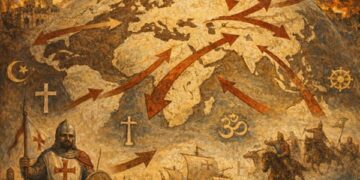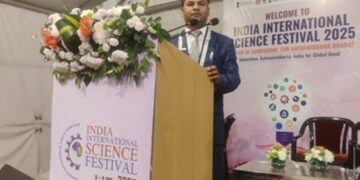By: MOHD ISHAQ SHAH
Mary Agenes Gonxa Bojaxhiu (26 August 1910 – 5 September 1997), better known as Mother Teresa, was an Albanian-Indian Catholic nun and the founder of the Missionaries of Charity. Born in Skopje, then part of the Ottoman Empire, at the age of 18 she moved to Ireland and later to India, where she lived most of her life. On 4 September 2016, she was canonized by the Catholic Church as Saint Teresa of Calcutta. The anniversary of her death, 5 September, is her feast day.
Mother Teresa founded Missionaries of Charity, a religious congregation, which grew to have over 4,500 nuns across 133 countries as of 2012The congregation manages homes for people who are dying of HIV/AIDS, leprosy, and tuberculosis. The congregation also runs soup kitchens, dispensaries, mobile clinics, children’s and family counselling programmes, as well as orphanages and schools. Members take vows of chastity, poverty, and obedience and also profess a fourth vow: to give “wholehearted free service to the poorest of the poor.”
Mother Teresa received several honours, including the 1962 Ramon Magsaysay Peace Prize and the 1979 Nobel Peace Prize. A controversial figure during her life and after her death, Mother Teresa was admired by many for her charitable work, but was criticised for her views on abortion and contraception, as well as the poor conditions in her houses for the dying. Her authorised biography, written by Navin Chawla, was published in 1992, and she has been the subject of many other works. On 6 September 2017, Mother Teresa and Saint Francis Xavier were named co-patrons of the Roman Catholic Archdiocese of Calcutta.
On 10 September 1946, Teresa experienced what she later described as “the call within the call” when she travelled by train to the Loreto convent in Darjeeling from Calcutta for her annual retreat. “I was to leave the convent and help the poor while living among them. It was an order. To fail would have been to break the faith.”[36] Joseph Langford, MC, founder of her congregation of priests, the Missionaries of Charity Fathers, later wrote, “Though no one knew it at the time, Sister Teresa had just become Mother Teresa”.
She began missionary work with the poor in 1948, replacing her traditional Loreto habit with a simple, white cotton sari with a blue border. Mother Teresa adopted Indian citizenship, spent several months in Patna to receive basic medical training at Holy Family Hospital and ventured into the slums. She founded a school in Motijhil, Calcutta, before she began tending to the poor and hungry. At the beginning of 1949, Mother Teresa was joined in her effort by a group of young women, and she laid the foundation for a new religious community helping the “poorest among the poor”.
Her efforts quickly caught the attention of Indian officials, including the prime minister. Mother Teresa wrote in her diary that her first year was fraught with difficulty. With no income, she begged for food and supplies and experienced doubt, loneliness and the temptation to return to the comfort of convent life during these early months. “Our Lord wants me to be a free nun covered with the poverty of the cross. Today, I learned a good lesson. The poverty of the poor must be so hard for them. While looking for a home I walked and walked till my arms and legs ached. I thought how much they must ache in body and soul, looking for a home, food and health. Then, the comfort of Loreto [her former congregation] came to tempt me- You have only to say the word and all that will be yours again. The Tempter kept on saying. … Of free choice, my God, and out of love for you, I desire to remain and do whatever be your Holy will in my regard. I did not let a single tear come”.
On 7 October 1950, Mother Teresa received Vatican permission for the diocesan congregation, which would become the Missionaries of Charity. In her words, it would care for “the hungry, the naked, the homeless, the crippled, the blind, the lepers, all those people who feel unwanted, unloved, uncared for throughout society, people that have become a burden to the society and are shunned by everyone”.
In 1952, Mother Teresa opened her first hospice with help from Calcutta officials. She converted an abandoned Hindu temple into the Kalighat Home for the Dying, free for the poor, and renamed it Kalighat, the Home of the Pure Heart (Nirmal Hriday). Those brought to the home received medical attention and the opportunity to die with dignity in accordance with their faith: Muslims were to read the Quran, Hindus received water from the Ganges, and Catholics received extreme unction. “A beautiful death”, Mother Teresa said, “is for people who lived like animals to die like angels—loved and wanted.”
Her Contribution towards humanity:She opened a hospice- Nirmal Hriday, Mother Teresa’s Calcutta hospice, in 2007, for those with leprosy, calling it Shanti Nagar (City of Peace). The Missionaries of Charity established leprosy-outreach clinics throughout Calcutta, providing medication, dressings and food.
The Missionaries of Charity took in an increasing number of homeless children; in 1955, Mother Teresa opened Nirmala Shishu Bhavan, the Children’s Home of the Immaculate Heart, as a haven for orphans and homeless youth. The congregation began to attract recruits and donations, and by the 1960s it had opened hospices, orphanages and leper houses throughout India.
Mother Teresa then expanded the congregation abroad, opening a house in Venezuela in 1965 with five sisters. Houses followed in Italy (Rome), Tanzania and Austria in 1968, and, during the 1970s, the congregation opened houses and foundations in the United States and dozens of countries in Asia, Africa and Europe. The Missionaries of Charity Brothers was founded in 1963, and a contemplative branch of the Sisters followed in 1976. Lay Catholics and non-Catholics were enrolled in the Co-Workers of Mother Teresa, the Sick and Suffering Co-Workers, and the Lay Missionaries of Charity.
Responding to requests by many priests, in 1981, Mother Teresa founded the Corpus Christi Movement for Priests and with Joseph Langford founded the Missionaries of Charity Fathers in 1984 to combine the vocational aims of the Missionaries of Charity with the resources of the priesthood.
World level acclimation: Mother Teresa is the subject of the 1969 documentary film and 1972 book, Something Beautiful for God, by Malcolm Muggeridge. The film has been credited with drawing the Western world’s attention to Mother Teresa. Christopher Hitchens’ 1994 documentary, Hell’s Angel, argues that Mother Teresa urged the poor to accept their fate; the rich are portrayed as favored by God. It was the precursor of Hitchens’ essay, The Missionary Position: Mother Teresa in Theory and Practice. Mother of The Century (2001) and Mother Teresa (2002) are short documentary films, about the life and work of Mother Teresa among the poor of India, directed by Amar Kumar Bhattacharya. They were produced by the Films Division of the Government of India. Mother Teresa: No Greater Love (2022) is a documentary film featuring unusual access to institutional archives and how her vision to serve Christ among the poor is being implemented through the Missionaries of Charity.
Conclusion: So the legacy that such great person like Mother Teresa has left behind is a therapy to the current human world that is devoid of moral obligations and ethical compulsions. Such legacies are light houses to this world that seems to have been lost in the darkness of greed, corruption, rudeness, inhuman dearth, fraudulency and many more predicaments. On this very day, let’s make a commitment to God that we shall live only to serve the divine purpose and work for the humanity for which reason we have been created.




